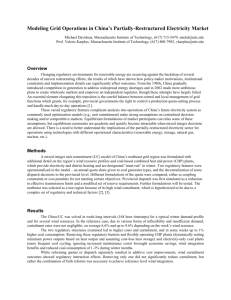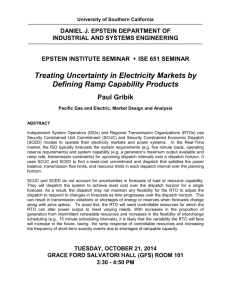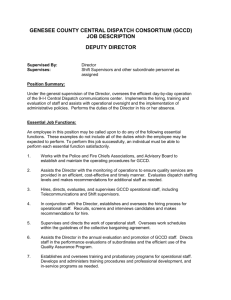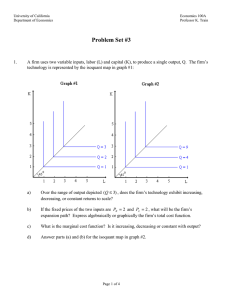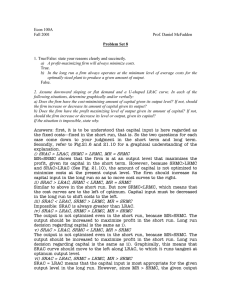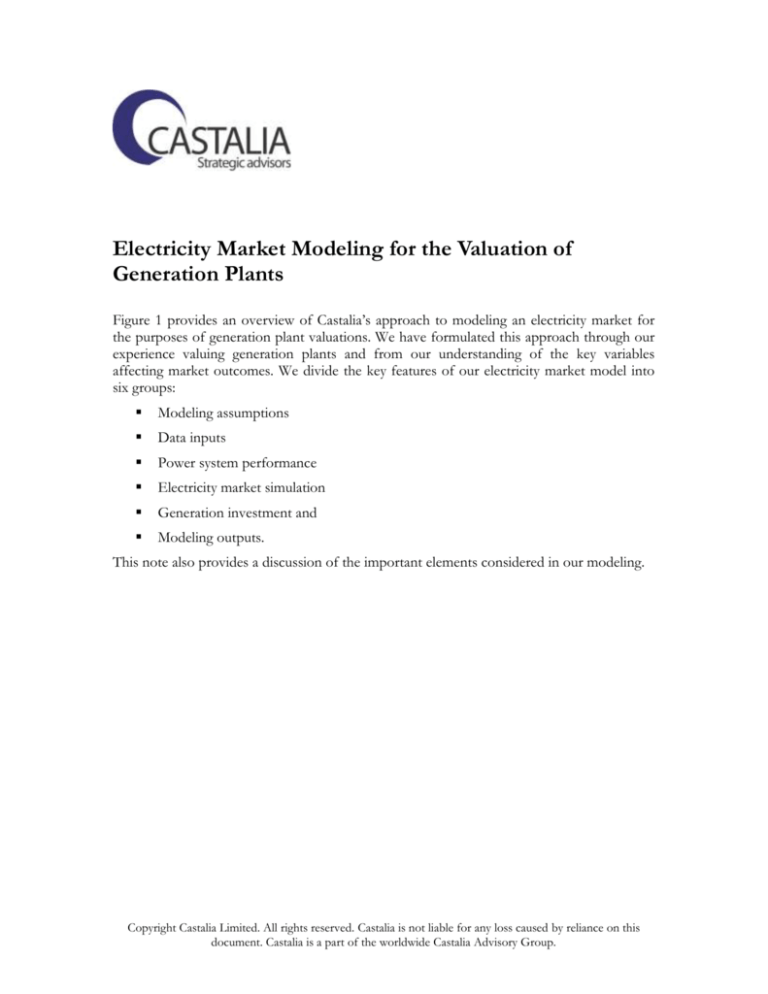
Electricity Market Modeling for the Valuation of
Generation Plants
Figure 1 provides an overview of Castalia’s approach to modeling an electricity market for
the purposes of generation plant valuations. We have formulated this approach through our
experience valuing generation plants and from our understanding of the key variables
affecting market outcomes. We divide the key features of our electricity market model into
six groups:
Modeling assumptions
Data inputs
Power system performance
Electricity market simulation
Generation investment and
Modeling outputs.
This note also provides a discussion of the important elements considered in our modeling.
Copyright Castalia Limited. All rights reserved. Castalia is not liable for any loss caused by reliance on this
document. Castalia is a part of the worldwide Castalia Advisory Group.
Figure 1: The Castalia Modeling Suite for Valuing Generation Plants
MODELING ASSUMPTIONS
Wholesale market scenarios
are formulated using differing
assumptions on generator
competition, regulatory
measures and market entry
Generator offers into spot
market assumed to be above
SRMC, scaled to match
specified wholesale market
scenario
GENERATION INVESTMENT
DATA INPUTS
Revised local
GDP forecasts
Load profiles
(weekday, weekend,
seasonal)
Transmission grid
capacities and
impedances
Generation plant
capacities and
operational
constraints
POWER SYSTEM PERFORMANCE
Forecast peak and energy
electricity demand using
simple econometric model
ELECTRICITY MARKET SIMULATION
Simulate electricity market
dispatch using load duration
curve and generation merit order
Nodal price and dispatch
model estimates:
· Location factors (spot price
differentials)
· Average grid losses
Allowing for:
· Transmission constraints
· Ramp rate constraints
If binding system constraints are
present, the full nodal price and
dispatch model is used to
simulate market outcomes
Price duration curve
provides profitability of
new capacity of each
generation type
Generation expansion path
is projected in accordance
with least-cost expansion
Wholesale prices converge
to LRMC as market
develops and competition
intensifies
MODELING OUTPUTS
·
·
·
Generation dispatch quantities
Spot market (or contract market)
revenue
Fixed and variable operating costs
Generator pre-tax cash operating surplus
2
Wholesale market scenarios depend on assumptions outside the modeling regarding: the
intensity of competition between generation owners (affected by the degree of ownership
break-up achieved by the privatization program), regulation of earnings through vesting
contracts and possible over-capacity through premature construction of new generation.
These assumptions are encapsulated in wholesale market scenarios for average wholesale
spot prices, which will be consistent with achievable baseload wholesale contract earnings.
GDP forecasts are required to help forecast electricity demand growth. Domestic
government forecasts of economic growth are often inflated so we counterbalance local
views with forecasts from international sources such as the IMF World Economic Outlook
Database.
Load profiles are obviously crucial inputs to modeling dispatch. We extract representative
weekday and weekend profiles from market data and allow for seasonal variations as well.
Transmission grid parameters are required for the nodal pricing and dispatch model. Most
power markets provide participants with comprehensive information about the transmission
network and this is generally made available to bidders in privatization processes.
Electricity demand forecasts drive the dispatch and new capacity modeling. Using past
demand growth trends and a simple econometric model of the relationship between
economic growth and electricity demand growth, we develop scenarios for peak and energy
demand growth, essentially forecasting the development of the full load profiles.
Generation plant capacities complete the inputs required for modeling dispatch. Plant
capacities are generally registered with, and published by, the system operator and more
detailed information on the plants of most interest is generally provided in information
memoranda. Memoranda usually include outage histories, heat rates and operational
constraints like limits on ramping. We generally have to make our own estimates of plant
short run marginal costs (SRMCs), principally combining achievable heat rates and forecasts
of regional fuel prices.
The nodal price and dispatch model combines generation and transmission capacities
with load forecasts and estimates plant utilization by mimicking the optimization software
used in the operation of the actual commercial spot market. As explained below, we assume
that price “offers” by generators of plant into the spot market are in the same order as the
plants’ short-run marginal costs thus yielding efficient dispatch. The model captures the
effect of any constraints in the transmission grid or in plant operation and calculates nodal
prices at each point in the grid—expressed in “location factors” relative to spot prices at
some central grid point.
Electricity market dispatch is simulated over the load profile for each future year. In most
settings transmission constraints are unlikely to persist and plant operational constraints are
minor. In these cases we use location factors from the nodal price model but can simplify
the dispatch simulation substantially by treating half hourly loads independently. The
approach is illustrated in the figure below and explained in the following paragraphs.
Different types of plant have different SRMCs. In the wholesale market, plants compete with
each other to supply power. Generation owners are free to bid whatever price they like, but
clearly will not usually offer to supply power at less than SRMC.
In circumstances where plants are competing with each other, competition can drive prices
down toward the SRMC for the marginal plant. (This is because each of the competing plants
3
wants to be dispatched, and so will try to offer a lower price than the other plants, subject to
still covering its variable costs).
For these reasons it is useful to analyze the supply of generation by considering the SRMCs
of the available plants. We do this by developing a ‘generator stack’. A generator stack simply
adds up the capacity of the available generators by type, starting from those with the lowest
SRMC and moving up to those with the highest SRMC. The idea is that, in general, demand
will be met first by plant with the lowest SRMC. Then in periods with higher demands,
progressively more expensive plant will be dispatched.
The figure depicts the generator stack for a typical modest sized power system. The
horizontal slices represent the MW capacities of the plants offered to the market. Plants with
very low SRMCs or take or pay fuel contracts are low in the stack, coal plants are likely to be
in the middle and oil-fired plants are at the top.
Load Duration Curve/Capacity Stack Analysis
Oil OCGT 2
12,000
12
11,000
11
10,000
10
9,000
9
8,000
8
7,000
7
MW 6,000
6
5,000
5
4,000
4
Coal 1
3,000
3
Gas take or pay
2,000
2
Coal minimum running
1,000
1
Baseload geothermal
0
average SSRMC
Oil OCGT 1
Oil CCGT
Variable natural gas
Variable geothermal
0
0.0
0.1
0.2
0.3
0.4
0.5
0.6
proportion of the year
0.7
0.8
0.9
1.0
c/kWh
Coal 5
Coal 4
Coal 3
Coal 2
SSRMC
LDC
The figure also shows the Load Duration Curve (LDC), the downward sloping solid black
curve. This shows how high demand is for each period of the year, with the separate half
hourly loads depicted in size order. Efficient dispatch requires that just those plants below
the LDC in the stack will be dispatched in each period of the year. The load duration curve
is “augmented”—especially at peak times—time allow for the effect of outages on the
dispatch of peaking plants.
Hence the figure depicts directly the efficient utilization of each plant, 100 percent for the
lower-order plants and minimum running levels, moderate plant factors for coal and gas
plants with intermediate fuel costs, and only light utilization of the peaking plants that have
high fuel costs.
4
Finally, the figure also shows, for each period of the year, the SRMC of the plant that is on
the margin (that is, the highest plant in the stack that is dispatched)—assuming efficient
dispatch. The SRMC “price duration curve” is shown in the figure as the yellow line stepping
downwards to the right. The curve records the proportions of the year during which the
SRMC is above the level indicated on the right-hand axis. A yellow spot on this axis shows
the annual average of the SRMCs.
Actual generator offers will generally be above SRMCs. Usually the number of competing
generator firms is small and the firms “game” the market to keep spot prices up so as to be
able to persuade retailers to buy short-to-medium-term contracts at higher prices. In a
“Cournot” approach to modeling the outcome of this gaming, the rising sequence of SRMC
offers is simply scaled up. The offers are thus in the same order as SRMCs and dispatch is
efficient—the same as it would be with SRMC offers. We choose the scaling parameter so
that the average of spot prices matches the relevant wholesale market scenario described
earlier.
The spot market price duration curve indicates the potential earnings of additional
capacity. The area under the curve and above a price level on the right-hand axis
corresponding to the offer price of the prospective new plant is the hourly profit per kW of
new capacity.
We assume that the generation expansion path is driven by market fundamentals rather
than by spot market power. Accordingly, we forecast expansion of each type of capacity on
the basis of the yellow SRMC price duration curve in the figure, evolving as demand grows.
In the long run we assume that supply and demand come into balance and average wholesale
prices converge to LRMCs.
5

